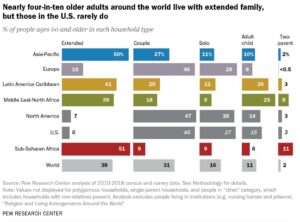National Senior Health and Fitness Day: What Can We Do?
Around the world in over 130 other countries only 16% of individuals over the age of 60 live by themselves where in the United States that statistic is nearly double to 27% of all individuals over the age of 60 live alone.
As we focus this day and the commitment to the health and fitness to those over 60, we want to focus on the overall health, including, their Mental Health.

From the PEW Research Center
As you go further you can see that Asia-Pacific, Sub-Saharan Africa and the Middle East-North Africa regions – such as Afghanistan, Mali and Algeria fewer than 5% of seniors live alone.
Let’s get into; What We Can Do
According to a study conducted by the AARP Foundation, 43% of adults over 60 years old reported feeling lonely. Loneliness can have a significant impact on physical and mental health, leading to increased risk of depression, anxiety, and other health problems. It is essential that we take action to reduce loneliness among seniors and improve their overall well-being.
Again this begs the question what can we do to fight this growing problem?
- Encourage social connections: Seniors should be encouraged to engage in social activities that interest them. This can be anything from joining a local book club to volunteering in their community. Encouraging social connections can help seniors feel more connected to their community and improve their mental health.
- Support technology use: How many people do you know that are guilty of having technical issues with their own phone? I know I am.. Technology can be an excellent way for seniors to stay connected with family and friends. We can help seniors learn how to use technology to stay connected and communicate with their loved ones. Many community centers and libraries offer free technology classes for seniors.
- Promote physical activity: Physical activity can have a significant impact on mental health and well-being. Encourage seniors to engage in physical activities that they enjoy, such as walking, yoga, or swimming. Physical activity can also be an excellent way for seniors to meet new people and build social connections.
- Offer transportation: Lack of transportation can be a significant barrier to social engagement for seniors. We can work to provide transportation options for seniors to attend social events or activities, such as community centers or volunteer opportunities.
- Address health concerns: Many seniors may have underlying health concerns that can contribute to loneliness. It is important to address these health concerns and provide seniors with the necessary resources and support to manage their health.
Reducing loneliness among seniors over 60 years old in the United States is a critical issue that requires our attention. By taking all these steps we are helping curb so many mental health issues that are at risk of prevalence when we forget to check in with those that are looking to connect and remain a part of our community, and our lives.
See Sources Below:
- AARP Foundation. (2018). Loneliness and Social Connections: A National Survey of Adults 45 and Older. Retrieved from https://www.aarp.org/content/dam/aarp/research/surveys_statistics/life-leisure/2018/loneliness-social-connections-survey.doi.10.26419-2Fres.00234.001.pdf
- National Institute on Aging. (2021). Loneliness and Social Isolation Linked to Serious Health Conditions. Retrieved from https://www.nia.nih.gov/news/loneliness-and-social-isolation-linked-serious-health-conditions
- National Council on Aging. (2021). Improving Social Connectedness for Older Adults. Retrieved from https://www.ncoa.org/resources/improving-social-connectedness-for-older-adults/
- U.S. Department of Health and Human Services. (2021). Physical Activity and Health. Retrieved from https://www.cdc.gov/physicalactivity/basics/older_adults/index.htm
- U.S. Department of Transportation Federal Transit Administration. (2021). Transportation for Seniors. Retrieved from https://www.transit.dot.gov/regulations-and-guidance/transportation-seniors
- American Psychological Association. (2019). How to Help Older Adults Stay Connected During the COVID-19 Pandemic. Retrieved from https://www.apa.org/topics/covid-19/older-adults-connected
- PEW Research Center.(2020) Older People are more likely to live alone in the U.S, than elsewhere in the World, Retrieved from https://www.pewresearch.org/short-reads/2020/03/10/older-people-are-more-likely-to-live-alone-in-the-u-s-than-elsewhere-in-the-world/#:~:text=But%20in%20the%20United%20States,130%20countries%20and%20territories%20studied.
